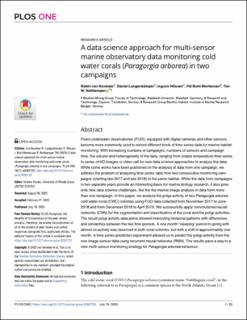| dc.contributor.author | van Kevelaer, Robin | |
| dc.contributor.author | Langenkämper, Daniel | |
| dc.contributor.author | Nilssen, Ingunn | |
| dc.contributor.author | Buhl-Mortensen, Pål | |
| dc.contributor.author | Nattkemper, Tim W. | |
| dc.date.accessioned | 2023-10-05T11:13:18Z | |
| dc.date.available | 2023-10-05T11:13:18Z | |
| dc.date.created | 2023-09-14T12:15:59Z | |
| dc.date.issued | 2023 | |
| dc.identifier.citation | PLOS ONE. 2023, 18 (7), . | en_US |
| dc.identifier.issn | 1932-6203 | |
| dc.identifier.uri | https://hdl.handle.net/11250/3094465 | |
| dc.description.abstract | Fixed underwater observatories (FUO), equipped with digital cameras and other sensors, become more commonly used to record different kinds of time series data for marine habitat monitoring. With increasing numbers of campaigns, numbers of sensors and campaign time, the volume and heterogeneity of the data, ranging from simple temperature time series to series of HD images or video call for new data science approaches to analyze the data. While some works have been published on the analysis of data from one campaign, we address the problem of analyzing time series data from two consecutive monitoring campaigns (starting late 2017 and late 2018) in the same habitat. While the data from campaigns in two separate years provide an interesting basis for marine biology research, it also presents new data science challenges, like the the marine image analysis in data form more than one campaign. In this paper, we analyze the polyp activity of two Paragorgia arborea cold water coral (CWC) colonies using FUO data collected from November 2017 to June 2018 and from December 2018 to April 2019. We successfully apply convolutional neural networks (CNN) for the segmentation and classification of the coral and the polyp activities. The result polyp activity data alone showed interesting temporal patterns with differences and similarities between the two time periods. A one month “sleeping” period in spring with almost no activity was observed in both coral colonies, but with a shift of approximately one month. A time series prediction experiment allowed us to predict the polyp activity from the non-image sensor data using recurrent neural networks (RNN). The results pave a way to a new multi-sensor monitoring strategy for Paragorgia arborea behaviour. | en_US |
| dc.language.iso | eng | en_US |
| dc.title | A data science approach for multi-sensor marine observatory data monitoring cold water corals (Paragorgia arborea) in two campaigns | en_US |
| dc.title.alternative | A data science approach for multi-sensor marine observatory data monitoring cold water corals (Paragorgia arborea) in two campaigns | en_US |
| dc.type | Peer reviewed | en_US |
| dc.type | Journal article | en_US |
| dc.description.version | publishedVersion | en_US |
| dc.source.pagenumber | 25 | en_US |
| dc.source.volume | 18 | en_US |
| dc.source.journal | PLOS ONE | en_US |
| dc.source.issue | 7 | en_US |
| dc.identifier.doi | 10.1371/journal.pone.0282723 | |
| dc.identifier.cristin | 2175072 | |
| cristin.ispublished | true | |
| cristin.fulltext | original | |
| cristin.qualitycode | 1 | |
